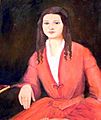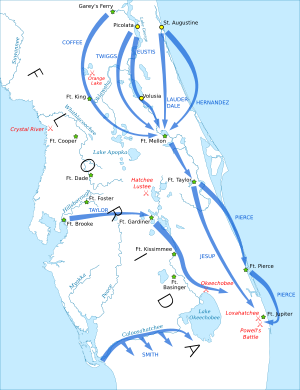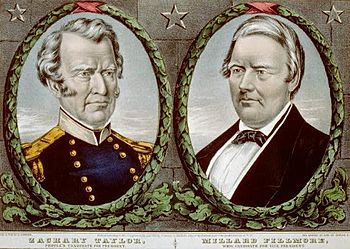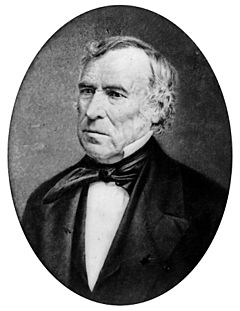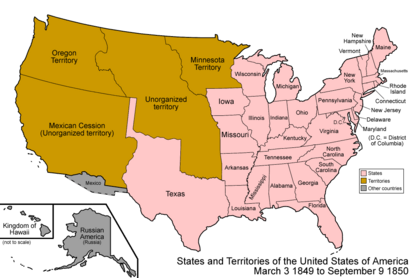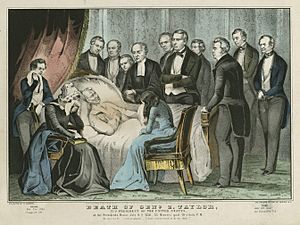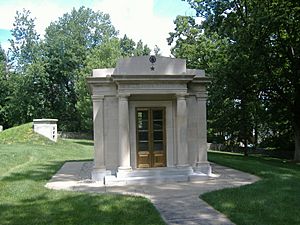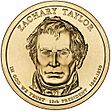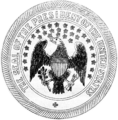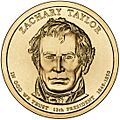Zachary Taylor facts for kids
Quick facts for kids
Zachary Taylor
|
|
|---|---|
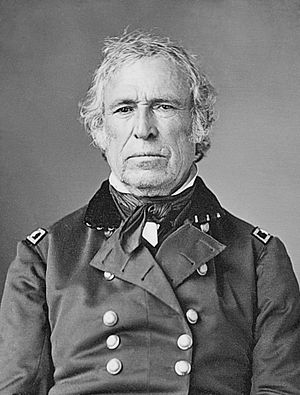
Taylor c. 1843-1845
|
|
| 12th President of the United States | |
| In office March 4, 1849 – July 9, 1850 |
|
| Vice President | Millard Fillmore |
| Preceded by | James K. Polk |
| Succeeded by | Millard Fillmore |
| Personal details | |
| Born | November 24, 1784 Barboursville, Virginia, U.S. |
| Died | July 9, 1850 (aged 65) Washington, U.S. |
| Resting place | Zachary Taylor National Cemetery |
| Political party | Whig |
| Spouse | |
| Children | 6, including Sarah, Mary, and Richard |
| Parents |
|
| Occupation |
|
| Awards | |
| Signature | |
| Military service | |
| Allegiance | |
| Branch/service | United States Army |
| Years of service | 1808–1849 |
| Rank | |
| Commands | Army of Occupation |
| Battles/wars | |
Zachary Taylor (November 24, 1784 – July 9, 1850) was an American military leader. He became the 12th president of the United States in 1849. He served as president until his death in 1850. Taylor was a soldier for his entire career in the United States Army. He rose to the rank of major general. He became a national hero for his wins in the Mexican–American War.
Because of his fame, he won the election to the White House. This happened even though his political ideas were not very clear. As president, his main goal was to keep the United States united. He died after only 16 months in office from a stomach disease. This made his presidency the third shortest in U.S. history.
Taylor was born into a wealthy family of plantation owners. They moved from Virginia to Louisville, Kentucky, when he was young. He was the last president born before the U.S. Constitution was adopted. He joined the U.S. Army in 1808. He became well-known as a captain in the War of 1812. He moved up in the military ranks. He built forts along the Mississippi River. He became a colonel in the Black Hawk War in 1832. His success in the Second Seminole War made him famous across the country. He earned the nickname "Old Rough and Ready."
In 1845, during the annexation of Texas, President James K. Polk sent Taylor to the Rio Grande. This was because a battle with Mexico was expected over the disputed Texas–Mexico border. The Mexican–American War started in April 1846. Taylor defeated Mexican troops led by General Mariano Arista at the battles of Palo Alto and Resaca de la Palma. He forced Arista's troops out of Texas. Taylor then led his troops into Mexico. They defeated Mexican troops led by Pedro de Ampudia at the Battle of Monterrey. Taylor went further south even though he was told not to. He was greatly outnumbered, but he still defeated Mexican forces under General Antonio López de Santa Anna at the Battle of Buena Vista. Taylor's troops were later put under the command of Major General Winfield Scott. But Taylor remained very popular.
The Whig Party convinced Taylor to run for president in the 1848 election. He was not very interested in politics and his views were unclear. At the 1848 Whig National Convention, Taylor won the party's nomination. He beat Winfield Scott and former Senator Henry Clay. He won the election with New York politician Millard Fillmore as his running mate. They defeated Democratic Party candidates Lewis Cass and William Orlando Butler. They also beat a third-party effort led by former president Martin Van Buren and Charles Francis Adams Sr. of the Free Soil Party. Taylor was the first president elected without ever holding a political office before.
As president, he stayed distant from Congress and his Cabinet. This was a time when tensions threatened to divide the country. The debate over slavery in the Mexican Cession was the main political issue. It led to threats of states leaving the Union. Even though Taylor was from the South and owned slaves, he did not support slavery expanding. He wanted peace between the different parts of the country. To avoid the slavery issue, he told settlers in New Mexico and California to become states quickly. This helped set the stage for the Compromise of 1850.
Taylor died suddenly from a stomach disease on July 9, 1850. His administration had not achieved much. The Clayton–Bulwer Treaty was ratified, but no progress was made on the biggest issue: slavery. Vice President Fillmore became president and finished Taylor's term. Historians often rank Taylor lower among U.S. presidents. This is partly because his term was so short (16 months). He has been called "more a forgettable president than a failed one."
Contents
Early Life and Family
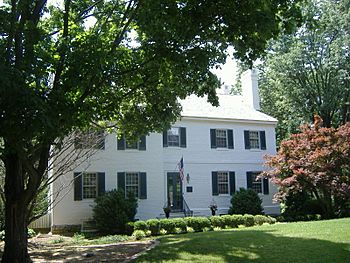
Zachary Taylor was born on November 24, 1784. He was born on a plantation in Orange County, Virginia. His family were well-known planters of English background. His birthplace might have been Hare Forest Farm, but it is not certain. He was the third of five sons who lived past infancy. He also had three younger sisters. His mother was Sarah Dabney (Strother) Taylor. His father, Richard Taylor, was a lieutenant colonel in the American Revolution.
Taylor's family moved west from Virginia to Louisville, Kentucky. They settled near the Ohio River. Taylor grew up in a small cabin. Later, as his family became richer, they moved to a brick house. When he was a child, he lived in an area where American Indian Wars battles took place. Louisville grew quickly, which helped Taylor's father. By the early 1800s, his father owned over 10,000 acres (40 km²) of land in Kentucky. He also owned 26 slaves to work on his land. Taylor's schooling was not regular. Kentucky's education system was just starting when he was young.
Taylor's mother taught him to read and write. He later went to a school run by Elisha Ayer. Ayer said Taylor learned quickly. However, Taylor's early letters showed poor spelling and grammar. His handwriting was also hard to read. These things improved over time.
Marriage and Children
In June 1810, Taylor married Margaret Mackall Smith. He had met her the year before in Louisville. Margaret came from a well-known family in Maryland. Her father was Major Walter Smith, who fought in the Revolutionary War. Zachary and Margaret had six children:
- Ann Mackall Taylor (1811–1875)
- Sarah Knox "Knoxie" Taylor (1814–1835). She married Jefferson Davis in 1835. He was an officer under her father. She died of malaria three months after her marriage.
- Octavia Pannell Taylor (1816–1820). She died young.
- Margaret Smith Taylor (1819–1820). She died as a baby.
- Mary Elizabeth "Betty" Taylor (1824–1909)
- Richard Taylor (1826–1879). He became a general in the Confederate Army.
Military Career
Joining the Army
On May 3, 1808, Taylor joined the U.S. Army. President Thomas Jefferson made him a first lieutenant. He was part of the new officers Congress hired after the Chesapeake–Leopard affair. This event, where a British warship attacked a U.S. Navy ship, almost led to war. Taylor spent much of 1809 in camps near New Orleans. Many soldiers there got sick. Taylor was given time off to recover in Louisville.
Taylor became a captain in November 1810. His army duties were light then. He bought bank stock and plantations in Louisville and Mississippi. These included over 200 slaves.
In July 1811, he went to the Indiana Territory. He took charge of Fort Knox. He brought order back to the fort. Governor William Henry Harrison praised him. Taylor was called to Washington to speak at a trial. So, he missed the November 1811 Battle of Tippecanoe against Tecumseh's forces.
War of 1812 Service
During the War of 1812, Taylor defended Fort Harrison in Indiana. He fought off an attack by Native Americans led by Tecumseh. This battle in September 1812 was the first U.S. land victory of the war. Taylor received much praise and was promoted to major. Later that year, Taylor helped General Samuel Hopkins on two trips. One was into Illinois Territory. The other was to the Tippecanoe battle site. They had to retreat in the Battle of Wild Cat Creek. Taylor moved his family to Fort Knox after the fighting stopped.
In 1814, Taylor led an expedition up the Mississippi River. In the Battle of Credit Island, Taylor defeated Native American forces. But he retreated when British allies joined them. When the war ended in 1815, he was reduced to captain and left the army. He rejoined a year later as a major.
Fighting in the Black Hawk War
In May 1828, Taylor was called back to duty. He commanded Fort Snelling in Michigan Territory (now Minnesota) for a year. Then he commanded Fort Crawford for another year. After a break, Taylor was promoted to colonel in April 1832. This was when the Black Hawk War began. Taylor fought under General Henry Atkinson. They pursued and defended against Chief Black Hawk's forces. The war ended in August 1832. It marked the end of Native American resistance in that area.
During this time, Taylor did not approve of his 17-year-old daughter, Sarah Knox Taylor, marrying Lieutenant Jefferson Davis. He respected Davis but knew military life was hard for families. Davis and Sarah Taylor married in June 1835. She was 21. But she died three months later from malaria.
The Second Seminole War
By 1837, the Second Seminole War was happening in Florida. Taylor built forts to help supply troops. He fought the Seminole Indians in the Battle of Lake Okeechobee on Christmas Day. This was one of the biggest U.S.–Indian battles of the 1800s. Because of this, he was promoted to brigadier general. In May 1838, Taylor took command of all American troops in Florida. He held this job for two years. His fame as a military leader grew. He became known as "Old Rough and Ready."
After his request to leave was granted, Taylor traveled the country. He met with military leaders. During this time, he became interested in politics. He wrote letters to President William Henry Harrison. In May 1841, he became commander of the Army's Western Division. This large area stretched from the Mississippi River west. Taylor was stationed in Arkansas. He had several peaceful years. He spent time on his land investments as well as military duties.
The Mexican–American War Begins
In April 1844, Taylor was sent to Fort Jesup in Louisiana. This was because Texas was expected to join the U.S. He was ordered to guard against Mexico trying to take back the territory. President James K. Polk chose Taylor because he was seen as not political. Polk told him to move his troops to the Rio Grande near Mexico. Taylor chose a spot at Corpus Christi. His Army of Occupation stayed there until the next spring. They expected a Mexican attack.
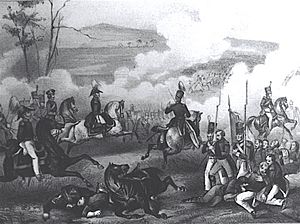
Polk tried to talk with Mexico, but it failed. Taylor's men moved to the Rio Grande in March 1846. War seemed very close. Fighting started weeks later. Mexican forces attacked some of Captain Seth B. Thornton's men. President Polk told Congress in May that war had begun.
That same month, Taylor led U.S. forces at the Battle of Palo Alto and Battle of Resaca de la Palma. Even though he was greatly outnumbered, he defeated the Mexican army. He forced them back across the Rio Grande. Taylor was praised for treating wounded Mexican soldiers kindly. He gave them the same care as American wounded. He also performed funeral rites for the dead from both sides.
These victories made him a hero. In May 1846, Taylor was promoted to major general. Congress officially praised him. In June, he became a full major general. People compared him to George Washington and Andrew Jackson. Both were generals who became president. But Taylor said he was not interested in running for office.
After crossing the Rio Grande, Taylor caused many casualties to the Mexicans at the Battle of Monterrey in September. He captured the city in three days. Taylor was criticized for signing a "liberal" truce. Polk wanted to occupy Northern Mexico to make Mexico sell Alta California and New Mexico. But Mexico did not want to give up so much land. Polk sent an army under Winfield Scott to attack Veracruz. Taylor was told to stay near Monterrey. Many of Taylor's experienced soldiers were moved to Scott's command. This left Taylor with a smaller force. Mexican General Antonio López de Santa Anna found out about Taylor's smaller force. He moved north to destroy Taylor's army before fighting Scott.
Taylor learned Santa Anna was coming. He refused to retreat, even though the Mexican army was much larger. Taylor set up a strong defense near Saltillo. Santa Anna attacked Taylor with 20,000 men at the Battle of Buena Vista in February 1847. About 700 Americans died or were wounded. Over 1,500 Mexican soldiers were casualties. The Mexican forces retreated, giving a big victory to the Americans.
Taylor stayed at Monterrey until late November 1847. Then he sailed home. He commanded the Army's entire western division for the next year. But his active military career was mostly over. In December, he received a hero's welcome in New Orleans and Baton Rouge. This set the stage for the 1848 presidential election.
Election of 1848
Taylor had never publicly shared his political beliefs before 1848. He had also never voted. He saw himself as an independent. He believed in a strong banking system. He thought it was not practical to expand slavery into the Western United States. This was because cotton and sugar, which used slave labor, could not easily grow there. He was also a strong American nationalist. He had seen many people die in war. So, he believed that states leaving the Union was a bad way to solve problems.
Even before his victory at Buena Vista, groups formed to support Taylor for president. His support came from many different political groups. These included Whigs and Democrats, Northerners and Southerners. By late 1846, Taylor was less against running for president. His ideas seemed to match the Whig Party's beliefs. Taylor disliked President Polk and his policies. The Whigs were looking for another war hero to nominate, like William Henry Harrison in 1840.
As support for Taylor grew, he stayed distant from both parties. But he said he would have voted for Whig Henry Clay in 1844. In a letter in September 1847, Taylor shared his views. He did not support a national bank. He favored low taxes on imports. He believed the president should not make laws. He thought the president could only veto laws if they were clearly against the Constitution.
Many Southerners thought Taylor supported slavery. Some were angry when Taylor suggested he would not veto the Wilmot Proviso. This proposal aimed to ban slavery in new territories. This position did not help him with anti-slavery groups in the North. Most abolitionists did not support Taylor because he owned slaves.
In February 1848, Taylor again said he would not accept a presidential nomination from either party. His refusal to call himself a Whig almost cost him the nomination. But Senator John J. Crittenden and others convinced him to declare himself a Whig. At the 1848 Whig National Convention, Taylor won the nomination. He beat Clay and Winfield Scott. For vice-president, the convention chose Millard Fillmore. Fillmore was a leading Whig from New York. His selection was an attempt to please northern Whigs. They were angry about nominating a slave-owning Southerner.
Taylor did not actively campaign. He preferred not to meet voters or discuss his political views. His campaign was managed by Crittenden. A late endorsement from Senator Daniel Webster also helped.
The Democrats were even more divided than the Whigs. Former Democratic President Martin Van Buren left the party. He led the anti-slavery Free Soil Party. Van Buren gained support from many Democrats and Whigs who opposed slavery in the territories. He took more votes from Democratic candidate Lewis Cass in New York.
Taylor defeated Cass and Van Buren. He won 163 of the 290 electoral votes. In the popular vote, he got 47.3%. Taylor was the last Whig to be elected president. He was also the last person elected president who was not from the Democratic Party or the Republican Party. He was the last Southerner to win a presidential election until Woodrow Wilson in 1912.
Presidency (1849–1850)
 |
|
|
Presidency of Zachary Taylor
|
|
|---|---|
| March 4, 1849 – July 9, 1850 | |
| Party | Whig |
| Election | 1848 |
| Seat | White House |
|
← James K. Polk • Millard Fillmore →
|
|
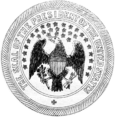 |
|
| Seal of the President (1850–1894) |
|
Becoming President
As president-elect, Taylor stayed away from Washington. He did not leave his military command until January 1849. He spent months choosing his cabinet. He was slow and quiet about his choices. He disliked political favors. But he had many people asking for jobs in his government.
Taylor did not choose Democrats. He wanted his cabinet to represent different parts of the country. He also avoided picking very famous Whigs. He saw Crittenden as a key person. He offered him the important job of Secretary of State. But Crittenden wanted to finish his term as governor of Kentucky. Taylor then chose Senator John M. Clayton of Delaware.
| The Taylor Cabinet | ||
|---|---|---|
| Office | Name | Term |
| President | Zachary Taylor | 1849–1850 |
| Vice President | Millard Fillmore | 1849–1850 |
| Secretary of State | John M. Clayton | 1849–1850 |
| Secretary of Treasury | William M. Meredith | 1849–1850 |
| Secretary of War | George W. Crawford | 1849–1850 |
| Attorney General | Reverdy Johnson | 1849–1850 |
| Postmaster General | Jacob Collamer | 1849–1850 |
| Secretary of the Navy | William Ballard Preston | 1849–1850 |
| Secretary of the Interior | Thomas Ewing | 1849–1850 |
With Clayton's help, Taylor chose the rest of his cabinet. One of Congress's first actions was to create the Department of the Interior. So Taylor would appoint its first secretary. Thomas Ewing became Secretary of the Interior. For Postmaster General, Taylor chose Congressman Jacob Collamer.
Taylor chose William M. Meredith as Secretary of the Treasury. George W. Crawford became Secretary of War. Congressman William B. Preston became Secretary of the Navy. Senator Reverdy Johnson became Attorney General. He was one of the most important members of Taylor's cabinet. Vice President Fillmore was not close to Taylor and had little power.
Taylor traveled to Washington in late January. The trip had bad weather, delays, and sickness. He finally arrived on February 24. He met with outgoing President Polk. Polk thought Taylor was "without political information" and "unqualified" to be president. Taylor spent the next week meeting with political leaders. He quickly finished choosing his cabinet.
Inauguration and Early Days
Taylor's term began on Sunday, March 4. But his inauguration was held the next day due to religious reasons. His inauguration speech talked about the nation's challenges. He said he would let Congress lead and seek compromise. He also stressed avoiding foreign alliances, like President Washington.
After his inauguration, Taylor met with many people. He also attended many funerals, including for Polk and Dolley Madison. Taylor was the first to use the term "First Lady" in his speech for Madison. In summer 1849, Taylor toured the Northeastern United States. He wanted to learn about that region. He was often sick during the trip. He returned to Washington by September.
The Slavery Crisis
When Taylor became president, Congress faced many questions about the Mexican Cession. This was land the U.S. gained after the Mexican War. It was unclear which areas would become states or territories. The biggest question was whether they would allow slavery. This threatened to divide Congress. Southerners did not want California, New Mexico, and Utah to join as free states.
Southerners were also angry that Northerners helped runaway slaves. Northern authorities often did not enforce the Fugitive Slave Act of 1793. Northerners wanted to end the slave trade in Washington DC. Also, Texas claimed parts of eastern New Mexico. It threatened to send its state army to take the land.
Taylor owned slaves himself. But he believed slavery would not work well in the Mexican Cession. So, he opposed slavery there. His main goal was peace and keeping the Union together. As the threat of Southern states leaving grew, he sided more with anti-slavery Northerners. He even said he would sign the Wilmot Proviso. This bill would ban slavery in federal territories.
Taylor thought the best way was to admit California as a state. This would keep the slavery question out of Congress's hands. The timing was good because the California Gold Rush was happening. California's population was growing very fast. Taylor sent a representative to California. He encouraged them to become a state. He knew Californians would ban slavery in their constitution. By October 1849, California voted to join the Union and ban slavery.
The border between New Mexico and Texas was also a problem. Texas claimed land north of Santa Fe. Taylor sided with New Mexico. He first wanted it to be a federal territory. But he later supported statehood to reduce the slavery debate. The Texas government tried to use its army to take the land. But it was not successful.
The Latter Day Saint settlers in Utah wanted to create a huge state. But Congress was unlikely to approve it. The Taylor administration decided to organize the Utah Territory. Taylor promised them religious freedom.
Taylor sent his only State of the Union report to Congress in December 1849. He talked about international events and suggested changes to taxes. But the slavery crisis was the main issue. He reported on California's and New Mexico's requests for statehood. He told Congress to approve them and avoid "exciting topics of a sectional character." His report was calm. But it ended with a strong warning against states leaving the Union. It did not change Southern lawmakers' minds. They saw two new free states as a big threat. Congress remained stuck.
Foreign Relations
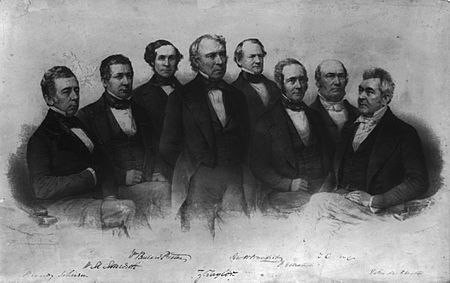
Taylor and his Secretary of State, John M. Clayton, were new to diplomacy. Their time in office was calm in foreign affairs. They both believed in American nationalism. Taylor let Clayton handle foreign policy. They supported German and Hungarian liberals in the revolutions of 1848. But they offered little help.
A problem with the French minister almost broke off relations. A dispute with Portugal led to harsh words from Taylor's government. In a positive effort, the administration sent two ships to help the United Kingdom. They were searching for British explorers lost in the Arctic.
Taylor's administration also dealt with Narciso López. He was a Venezuelan who tried to conquer Spanish Cuba. Many Southerners wanted Cuba to become a new slave state. López had some famous Southern supporters. But Taylor and Clayton saw his actions as illegal. They blocked his efforts and arrested him and his group. They were later found not guilty.
The most important foreign policy achievement was the Clayton–Bulwer Treaty of 1850. This treaty was about a possible canal through Central America. Both the U.S. and Britain agreed not to control any canal built in Nicaragua. This treaty helped create a good relationship between the U.S. and Britain. It was Taylor's last act as president.
Final Days and Death
Henry Clay played a key role as Congress debated slavery. Taylor kept his distance from Clay. This made Taylor politically isolated. Southerners disliked his idea of new free states. Northerners disliked his opposition to Clay's plans. So, Congress often ignored Taylor. Clay, with help from Daniel Webster, created the Compromise of 1850. This plan allowed California to be a free state. Other territories would stay under federal control. Texas would be paid for land it claimed in New Mexico.
Slavery would stay in Washington, D.C., but the slave trade would be banned. A strict Fugitive Slave Law would be passed. This would help Southerners get back runaway slaves.
Tensions grew as Congress debated. There were threats of states leaving the Union. Taylor even threatened to send troops into New Mexico to protect its border from Texas. He said he would lead the army himself. The crisis got worse when New Mexico proposed a constitution banning slavery. The new Texas governor, P. Hansborough Bell, promised to invade New Mexico. Southern senators accused Taylor of secretly sending the army. Taylor denied it but said he would if needed. He also said he would hang anyone "taken in rebellion against the Union."
No big compromise reached Taylor's desk. His last days were also overshadowed by a scandal. Secretary of War Crawford had received a large payment for a legal case before joining the cabinet. This caused embarrassment for Taylor. The House of Representatives criticized Taylor. Newspapers called for his impeachment.
In July 1850, Taylor became very ill. It was an unknown stomach illness. It seemed mild at first. But his condition worsened. He died at 10:35 p.m. on July 9, 1850. He was 65 years old. After his death, Vice President Fillmore became president. Fillmore later signed the Compromise of 1850 into law. This aimed to solve many of the issues Taylor faced.
Taylor was buried in the Public Vault in Washington, D.C. His body was later moved to the Taylor family plot in Louisville, Kentucky.
Legacy and Memorials
Because his time in office was short, Taylor is not seen as having a strong impact on the presidency. Some historians say he lacked political experience. However, the Clayton–Bulwer Treaty was an important step. It showed the U.S. was less focused on expanding its territory. Historians generally rank Taylor in the bottom quarter of U.S. presidents.
Taylor was the last president to own slaves while in office. He was the third of four Whig presidents. Taylor was also the second president to die in office. William Henry Harrison died nine years earlier.
In 1883, Kentucky placed a monument near Taylor's grave. In the 1920s, his family worked to make his burial grounds a national cemetery. On May 5, 1926, Taylor and his wife's remains were moved to a new mausoleum. The cemetery was named the Zachary Taylor National Cemetery in 1928.
The U.S. Post Office released the first postage stamp honoring Taylor on June 21, 1875. He appeared on stamps again in 1938 and 1986. Taylor was the fifth American president to appear on U.S. postage stamps.
Many places and things are named after Taylor, including:
- Camp Taylor in Kentucky
- Fort Zachary Taylor in Florida
- The SS Zachary Taylor, a World War II ship
- Zachary Taylor Parkway in Louisiana
- Zachary Taylor Hall at Southeastern Louisiana University
- Taylor County, Georgia
- Taylor County, Iowa
- Taylor County, Kentucky
- Rough and Ready, California
- Zachary Taylor Highway in Virginia
- Taylor, Michigan
- Taylor Street, Savannah, Georgia.
Theories About His Death
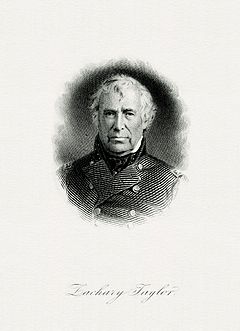
Soon after Taylor's death, rumors started that he had been poisoned. Some thought pro-slavery Southerners or Catholics were responsible. These theories continued into the 21st century. A review in 2010 concluded that there is no clear proof he was assassinated, nor that he was not.
Images for kids
-
General Zachary Taylor rides his horse at the Battle of Palo Alto, May 8, 1846
-
U.S. Steam Ship Monmouth returns U.S. General Zachary Taylor from victories in the war with Mexico at Balize, Louisiana, November 1847
-
Daguerreotype of Taylor by Mathew Brady, 1849
-
President Zachary Taylor standing in front of his Cabinet, seated from left: Reverdy Johnson, Attorney General; William M. Meredith, Secretary of the Treasury; William B. Preston, Secretary of the Navy; George W. Crawford, Secretary of War; Jacob Collamer, Postmaster General; Thomas Ewing, Secretary of the Interior; and John M. Clayton, Secretary of State. Lithograph by Francis D'Avignon, published by Mathew Brady, 1849.
-
Presidential dollar coin, 2009
-
B.E.P. engraved portrait
See also
 In Spanish: Zachary Taylor para niños
In Spanish: Zachary Taylor para niños
- Historical rankings of presidents of the United States
- List of presidents of the United States
- List of presidents of the United States by previous experience
- List of presidents of the United States who died in office
- List of presidents of the United States who owned slaves
- List of unsolved deaths
- Presidents of the United States on U.S. postage stamps



